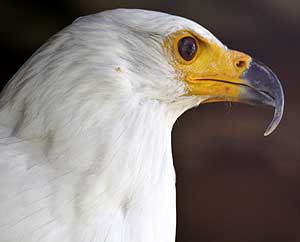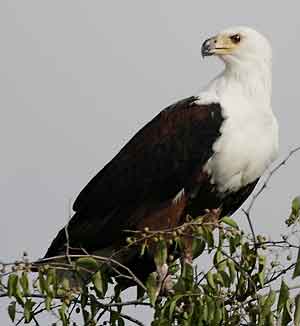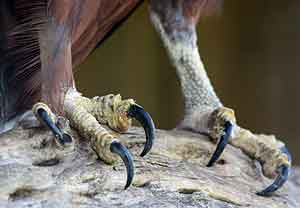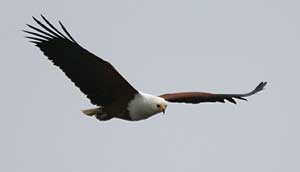Contact Details: Scotch Macaskill, Dirt Road Traders, Currys Post Road, Howick, KwaZulu-Natal, South Africa. Tel: +27 (0)82 578 2329. Privacy: Your privacy is guaranteed. See our Privacy Policy for more. This site accepts advertising and other forms of compensation - see Disclosure and Advertising for details. Site updated: 2022. Copyright © 2002 - 2022 Scotch Macaskill

| ||||||||||
|
||||||||||
|
SEE ALL
|
African Fish Eagle - Handsome Raptor with the Distinctive Callby Roddy SmithFor most of us aspiring birders the raptors can be a confusing maze of look-alikes and colour-changers. The African fish eagle, one of the most recognisable birds in sub-Saharan Africa, is a welcome exception. 
The handsome Fish Eagle is easily recognisable Fortunately these beautiful birds are still fairly common around Africa's lakes, dams and rivers, and in places along the coast (years ago it was known as the Cape Sea-eagle before aquiring its present more accurate name). The scientific name, Haliaeetus vocifer, is unusually commonsense and descriptive of its subject as these names go: Haliaeetus - a fish-eating eagle and vocifer as in vociferous, for these are not only our most easily recognised raptors but also our most vocal. The fish eagle's haunting cry is one of the most evocative sounds of the African bush. Like many raptors, fish eagles are monogamous and are believed to mate for life. Pairs generally remain within sight of each other for most of the day, and are intensely territorial. The size of territories varies according to food availability, and they are fiercely defended all year round by both partners, with the females being more aggressive and, as is usual with raptors, they are also bigger. 
Fish Eagle perched near water, scanning for prey At the sight of another fish eagle in the distance they will loudly proclaim their ownership; throwing their heads way back as they call whether they are perched or flying. If the intruder enters their air-space either partner may take to the air to see it off, or even physically attack it. This is a remarkable sight and one which I have been regularly failing to photograph for years; the resident bird attacks the intruder from below, and they lock claws and cartwheel downwards, sometimes for 100m or more. The first time I witnessed fish eagles spinning each other through the sky in this manner like a great feathered catherine-wheel I took it for some form of aerial courting dance, but it is in fact intense territoriality and sometimes the combatants hold on too long and crash into branches or the ground, resulting in injury or death. I have also frequently seen fish eagles harassing Goliath Herons; perhaps they recognise them as competition. The fish eagle is not the most active of birds, foraging for about 5-10% of the day, mostly from a perch but sometimes in flight. Its diet, unsurprisingly, consists mostly of fish which it usually catches by making a shallow swooping dive with its feet thrown forward to seize them 15 - 30 cm below the surface.

Close-up of African Fish Eagle's feet and talons The feet are specially adapted for this; in addition to the formidable talons they have small spikes on the underside which help to grip slippery fish. Fish eagles can lift fish up to about 2kg clear of the water and fly with them; they can fly with the fish weighing 2-3kg planing along the surface, and with anything heavier they paddle to shore using their wings and dragging the fish with them. Fish over 3kg are usually scavenged rather than caught. They also eat other things besides fish. Birds are usually attacked on the ground or in the water, but the fish eagle is a sufficiently agile flyer to catch birds in flight as well, and will also raid breeding colonies and seize eggs and nestlings. They also eat reptiles such as monitor lizards, terrapins and crocodile hatchlings and mammals including hyraxes, rodents and vervet monkeys. The fish eagle doesn't catch all its food itself; it is something of a pirate and frequently steals food from other birds. In most cases they take fish from large fishing birds such as pelicans, storks and herons, but they are not too proud to rob birds down to the size of pied kingfishers (which has to go down as bullying), and will also steal other prey including birds and snakes from other raptors. In an unusual inter-action I once saw a saddlebilled stork kill an African jacana and promptly have it stolen by a fish eagle. 
Fish Eagle soaring high in the African sky Perhaps this is a family tendency. The bald eagle (Haliaeetus leucocephalus) is a member of the same genus. Benjamin Franklin famously deplored its choice as the national bird of the United States on the ground that "He is a Bird of bad moral character. He does not get his Living honestly ...too lazy to fish for himself, he watches the Labour of the Fishing Hawk; and when that diligent Bird has at length taken a fish....the Bald Eagle ....takes it from him." Strictly speaking the African fish eagle is not considered to be a true eagle; its closest relations in the Southern African sub-region are probably the buzzards and kites. Despite this, and its disreputable American relations, this majestic and iconic bird is for most people the epitome of what an eagle should look like. Roddy Smith is a wildlife conservationist and safari guide based at Mwambashi River Lodge in the Lower Zambezi National Park, Zambia. Images © Scotch Macaskill Return to Wildlife Articles |
|||||||||
|
|
||||||||||